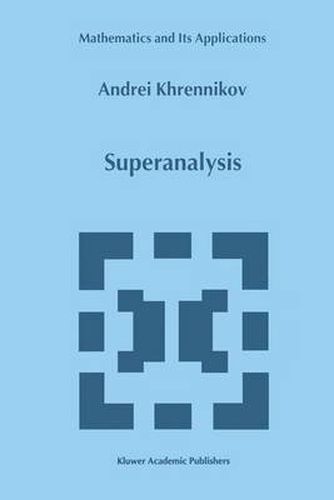Readings Newsletter
Become a Readings Member to make your shopping experience even easier.
Sign in or sign up for free!
You’re not far away from qualifying for FREE standard shipping within Australia
You’ve qualified for FREE standard shipping within Australia
The cart is loading…






This title is printed to order. This book may have been self-published. If so, we cannot guarantee the quality of the content. In the main most books will have gone through the editing process however some may not. We therefore suggest that you be aware of this before ordering this book. If in doubt check either the author or publisher’s details as we are unable to accept any returns unless they are faulty. Please contact us if you have any questions.
defined as elements of Grassmann algebra (an algebra with anticom muting generators). The derivatives of these elements with respect to anticommuting generators were defined according to algebraic laws, and nothing like Newton’s analysis arose when Martin’s approach was used. Later, during the next twenty years, the algebraic apparatus de veloped by Martin was used in all mathematical works. We must point out here the considerable contribution made by F. A. Berezin, G 1. Kac, D. A. Leites, B. Kostant. In their works, they constructed a new division of mathematics which can naturally be called an algebraic superanalysis. Following the example of physicists, researchers called the investigations carried out with the use of commuting and anticom muting coordinates supermathematics; all mathematical objects that appeared in supermathematics were called superobjects, although, of course, there is nothing super in supermathematics. However, despite the great achievements in algebraic superanaly sis, this formalism could not be regarded as a generalization to the case of commuting and anticommuting variables from the ordinary Newton analysis. What is more, Schwinger’s formalism was still used in practically all physical works, on an intuitive level, and physicists regarded functions of anticommuting variables as real functions == maps of sets and not as elements of Grassmann algebras. In 1974, Salam and Strathdee proposed a very apt name for a set of super points. They called this set a superspace.
$9.00 standard shipping within Australia
FREE standard shipping within Australia for orders over $100.00
Express & International shipping calculated at checkout
This title is printed to order. This book may have been self-published. If so, we cannot guarantee the quality of the content. In the main most books will have gone through the editing process however some may not. We therefore suggest that you be aware of this before ordering this book. If in doubt check either the author or publisher’s details as we are unable to accept any returns unless they are faulty. Please contact us if you have any questions.
defined as elements of Grassmann algebra (an algebra with anticom muting generators). The derivatives of these elements with respect to anticommuting generators were defined according to algebraic laws, and nothing like Newton’s analysis arose when Martin’s approach was used. Later, during the next twenty years, the algebraic apparatus de veloped by Martin was used in all mathematical works. We must point out here the considerable contribution made by F. A. Berezin, G 1. Kac, D. A. Leites, B. Kostant. In their works, they constructed a new division of mathematics which can naturally be called an algebraic superanalysis. Following the example of physicists, researchers called the investigations carried out with the use of commuting and anticom muting coordinates supermathematics; all mathematical objects that appeared in supermathematics were called superobjects, although, of course, there is nothing super in supermathematics. However, despite the great achievements in algebraic superanaly sis, this formalism could not be regarded as a generalization to the case of commuting and anticommuting variables from the ordinary Newton analysis. What is more, Schwinger’s formalism was still used in practically all physical works, on an intuitive level, and physicists regarded functions of anticommuting variables as real functions == maps of sets and not as elements of Grassmann algebras. In 1974, Salam and Strathdee proposed a very apt name for a set of super points. They called this set a superspace.